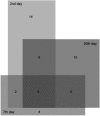Establishment of the bacterial fecal community during the first month of life in Brazilian newborns
- PMID: 22358235
- PMCID: PMC3275115
- DOI: 10.6061/clinics/2012(02)05
Establishment of the bacterial fecal community during the first month of life in Brazilian newborns
Abstract
Objective: The establishment of the intestinal microbiota in newborns is a critical period with possible long-term consequences for human health. In this research, the development of the fecal microbiota of a group of exclusively breastfed neonates living in low socio-economic conditions in the city of São Paulo, Brazil, during the first month of life, was studied.
Methods: Fecal samples were collected from ten neonates on the second, seventh, and 30(th) days after birth. One of the neonates underwent antibiotic therapy. Molecular techniques were used for analysis; DNA was extracted from the samples, and 16S rRNA libraries were sequenced and phylogenetically analyzed after construction. A real-time polymerase chain reaction (PCR) was performed on the samples taken from the 30(th) day to amplify DNA from Bifidobacterium sp.
Results: The primary phylogenetic groups identified in the samples were Escherichia and Clostridium. Staphylococcus was identified at a low rate. Bifidobacterium sp. was detected in all of the samples collected on the 30(th) day. In the child who received antibiotics, a reduction in anaerobes and Escherichia, which was associated with an overgrowth of Klebsiella, was observed throughout the experimental period.
Conclusion: The observed pattern of Escherichia predominance and reduced Staphylococcus colonization is in contrast with the patterns observed in neonates living in developed countries.
Conflict of interest statement
No potential conflict of interest was reported.
Figures





References
-
- Adlerberth I, Wold AE. Establishment of the gut microbiota in Western infants. Acta Pediatri. 2009;98(2):229–38. - PubMed
-
- Gothefors L, Carlsson B, Ahlstedt S, Hanson LA, Winberg J. Influence of maternal gut flora and colostral and cord serum antibodies on presence of Escherichia coli in faeces of the newborn infant. Acta Paediatr Scand. 1976;65(2):225–32. - PubMed
-
- Murono K, Fijita K, Yoshiokawa M, Saijo M, Inyaku F, Kakehashi H, et al. Acquisition of nonmaternal Enterobacteriaceae by infants delivered in hospitals. J Pediatr. 1993;122(1):120–5. - PubMed
-
- Adlerberth I, Lindberg E, Aberg N, Hesselmar B, Saalman R, Strannegård IL, et al. Reduced enterobacterial and increased staphylococcal colonization of infantile bowel: an effect of hygiene lifestyle. 2006;59(1):96–101. Pediatr Res. - PubMed
-
- Adlerberth I, Strachan DP, Matricardi PM, Ahrné S, Orfei L, Aberg N, et al. Gut microbiota and development of atopic eczema in 3 European birth cohorts. J Allergy Clin Immunol. 2006;120(2):343–50. - PubMed
MeSH terms
Substances
LinkOut - more resources
Full Text Sources
Medical
Molecular Biology Databases

